





|
 |
 |
 |
Tillandsia SWARM - experimental living plant sculptures by Lloyd Godman based on the principle of super sustainability - © Lloyd Godman
A ground breaking art/science experiment with Tillandsia plants that need no soil or watering system!

|
Following the success of the Airborne project and Eureka Tower Cage experiment, Tillandsia SWARM is an on going art science project where diminutive Tillandsia plants are installed at other iconic and challenging locations on buildings within the city to prove that plants can be integrated into a wide range of buildings with minimal infrastructure and maintenance.
Because there is no need for a watering system or soil substrate nutrients, there is no risk to the structural integrity of the location. It also means the plants can be mounted on animated aspects of a building or urban infrastructure. The plants are simply placed inside a mesh cage and left to their own biological devices.
Over time the project expands, the plants "swarm" creating a growing map of urban locations with experimental Tillandsias.
The Green haze.
“At Eureka Tower, ecological artist Lloyd Godman has planted Tillandsia plants in an experiment that could inform greening throughout the city. It is his hope to eventually install “hundreds of thousands” of Tillandsia on the outside landings of the building, and all across the city coating the precinct in a green haze”. Weekend Australian, Business Review 9-10 January 2016
Navigate the Tillandsia SWARM sites from the MAP
Tall building Council paper which is a more scientific paper on the Tillandsia work
Green Building Council paper which is a much more detailed paper

Tillandsia plant cages awaiting installation. |

|
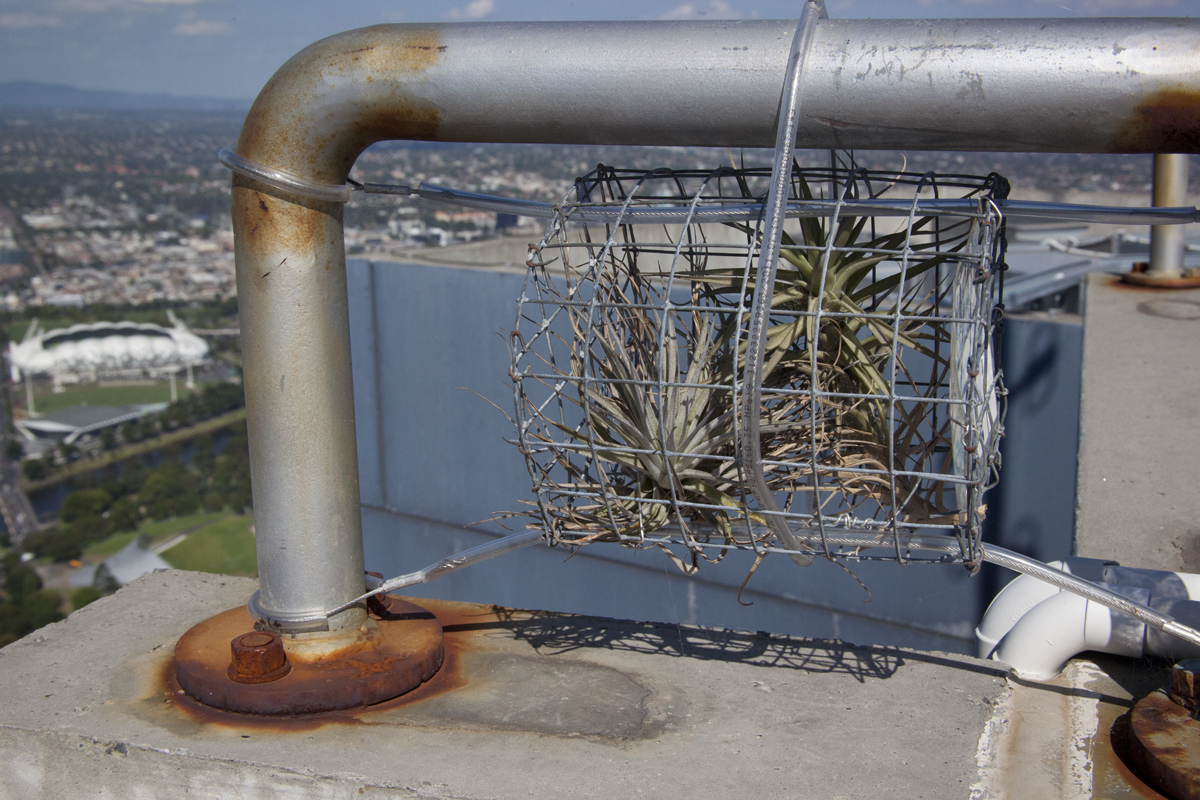 Tillandsia plant cage mounted at level 92 on Eureka Tower, Melbourne Tillandsia plant cage mounted at level 92 on Eureka Tower, Melbourne
|
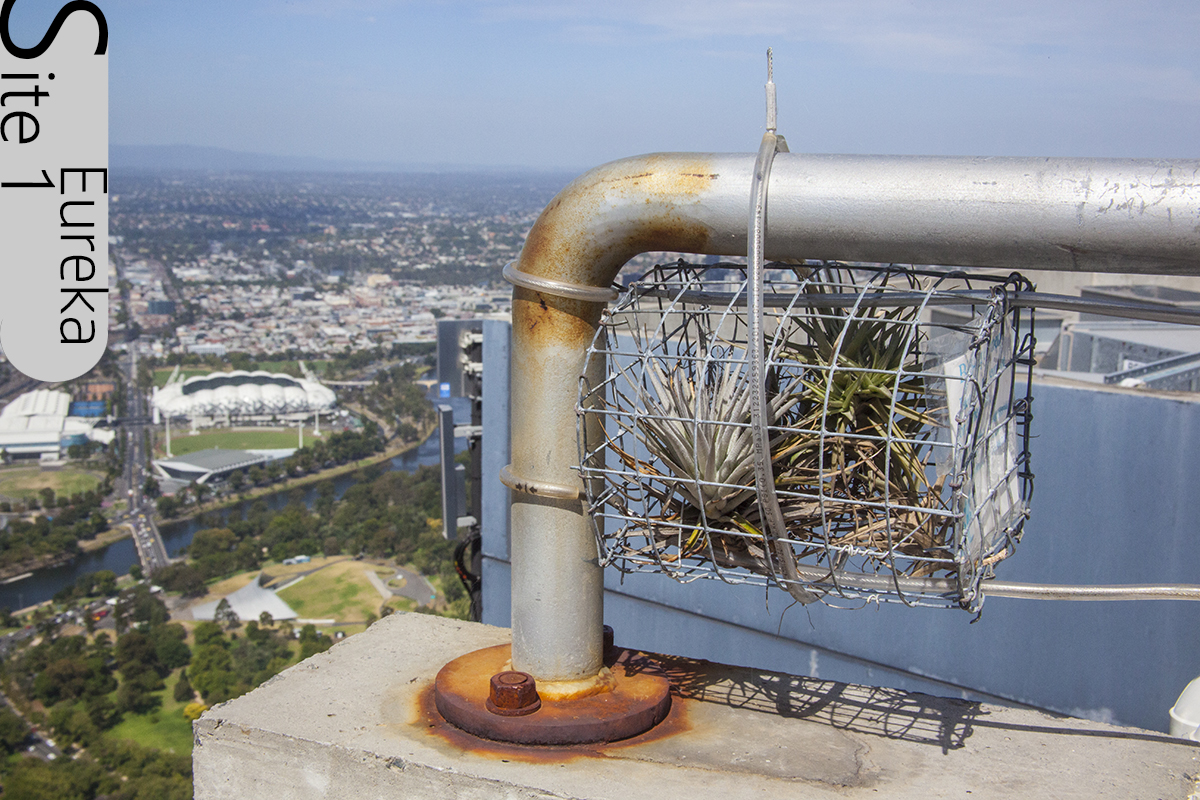
|
Tillandsia SWARM
consists of a diaspora of caged Tillandsias (air plants), scattered across a range of urban sites including Eureka Tower, CH2 Building, MGA, Montsalvat, Victorian Friends Center and Essendon Airport. The sophisticated biology of air plants enables them to up-take all water and nutrients through special cells on the leaf called trichomes, even absorbing toxic airborne heavy metal particulates. Further to this, through a process called a CAM cycle they are one of few plants that can exchange CO2 for oxygen at night offering a valuable means to filter the air.
|

|
Why is the title Tillandsia SWARM for this art project?
Forming a new colony
When we hear the word SWARM, we often think of a swarm of bees, where the hive separates and sets off to form a new colony. As the Tillandsia cells expand across the city they do so in a similar manner.
Swarm Intelligence in Plants
from Science News
They're underfoot and under appreciated. But the roots of a plant may demonstrate the remarkable wisdom of crowds just as swarms of honeybees or humans can. Three plant scientists now propose that roots growing this way and that in their dark and dangerous soil world may fit a definition for what's called swarm intelligence. Each tip in a root system acquires information at least partly independently, says plant cell biologist František Baluška of the University of Bonn in Germany. This also connects with Florianne Koechlin’s ideas about plant communication.
An interesting concept - So if many plants communicate via root structures because Tillandsia do not have real root structures do they communicate in other ways. The trichome cell on the leaf of these plants is highly adapted to preform many tasks of normal roots. Perhaps Tillandsia communicate via air waves through their Trichome cells?
Hybrid Swarm
Hybridization occurs in nature, and often the only barrier that prevents hybridization is geographic isolation, where two species are separated by vast distances or geological differences. The term swarmed is used when a naturally occurring hybrid is deemed to have become a species in its own right.
|
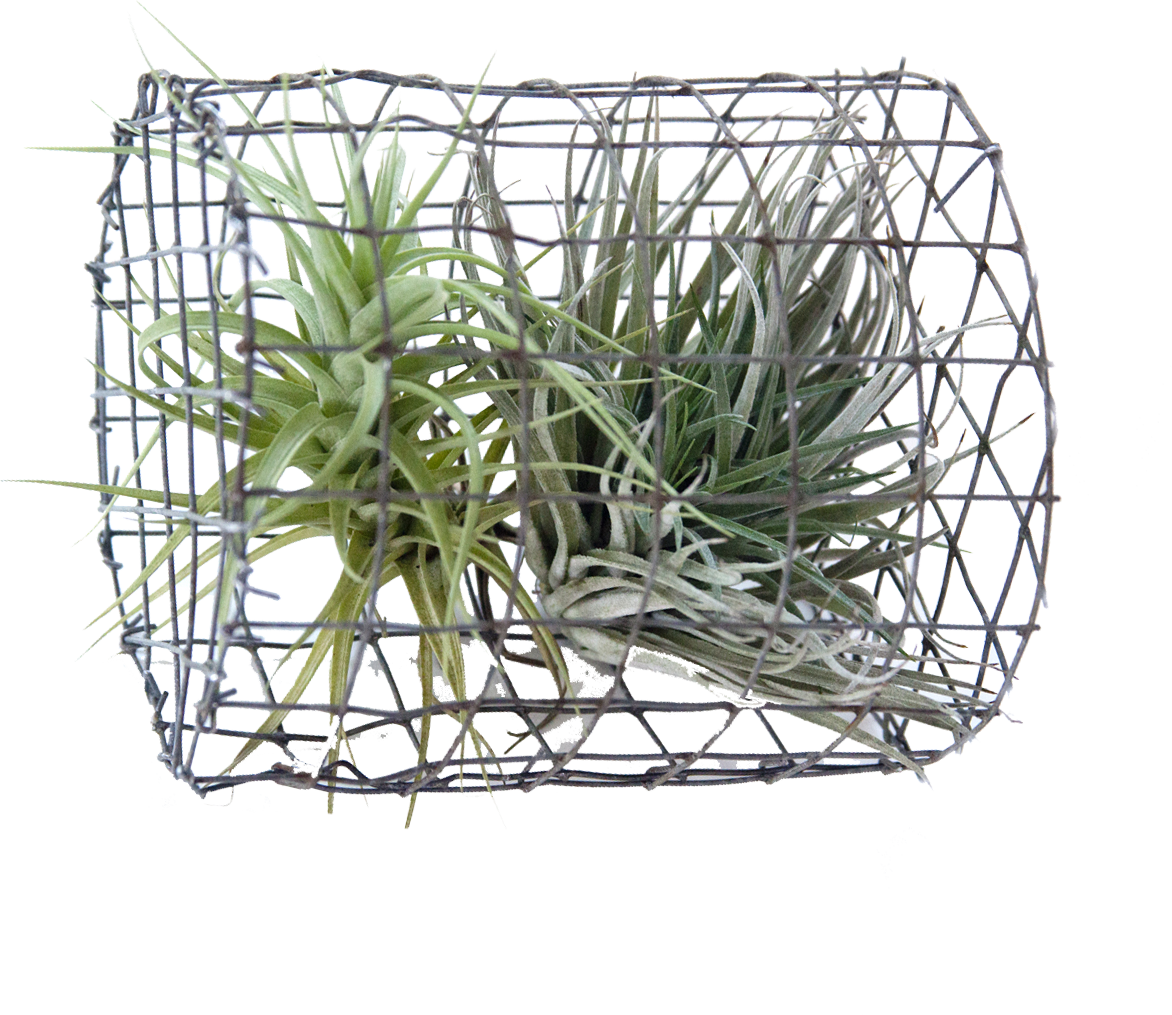 |
Tillandsia Cells
Placing the Tillandsia plants in mesh cages (cerlls) secures them to the structure in a secure manner. While this was essential for installations like the top of Eureka Tower where they might dislodge in winds exceeding 200kmph, it also suggests the idea of a "cell" as in a honey comb, and relates to the schematic SWARM map. |
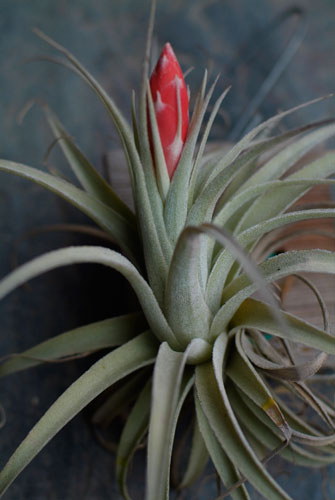 |
Tiilandsia
Tillandsias, commonly called air plants, are a genus of about 1000 species within the Bromeliad plant family that all but one originate from south, central and the southern part of north America. While Bromeliads are best know for the edible pineapple, Tillandsias have evolved the greatest range of species with curiously shaped plants forms.
Are they ancient plants?
No. There is a common belief that Bromelaids are ancient plants aligned with, cycads, ferns, but as angiosperms (flowering plants with sophisticated biological systems) they have actually developed quite recently. To put this in context what we might think of as ancient plants evolved about 300-400 Million years ago, where as ancient Bromeliads first evolved about 70-50 million years ago in South America. Dinosaurs are said to have died out about 65 million years ago.
About the same time as our ancestral forebears, the early apes, evolved on the planet (15 – 30 million years ago), the massive Andes mountain range thrust upward from intense tectonic activity. In the geological upheaval, countless life forms became stranded by high, rocky peaks and deep valleys. Increasingly, each species was exposed to a “rapidly” changing climate. Mostly drier, colder, and hotter. Relatively quickly (over a few million years), species either became locally/permanently extinct or evolved. More than any, Tillandsias, a genus of Bromeliads, diversified and about 1000 species evolved in an extremely short period. So they are a pertinent model for the changing climate we are now experiencing. |
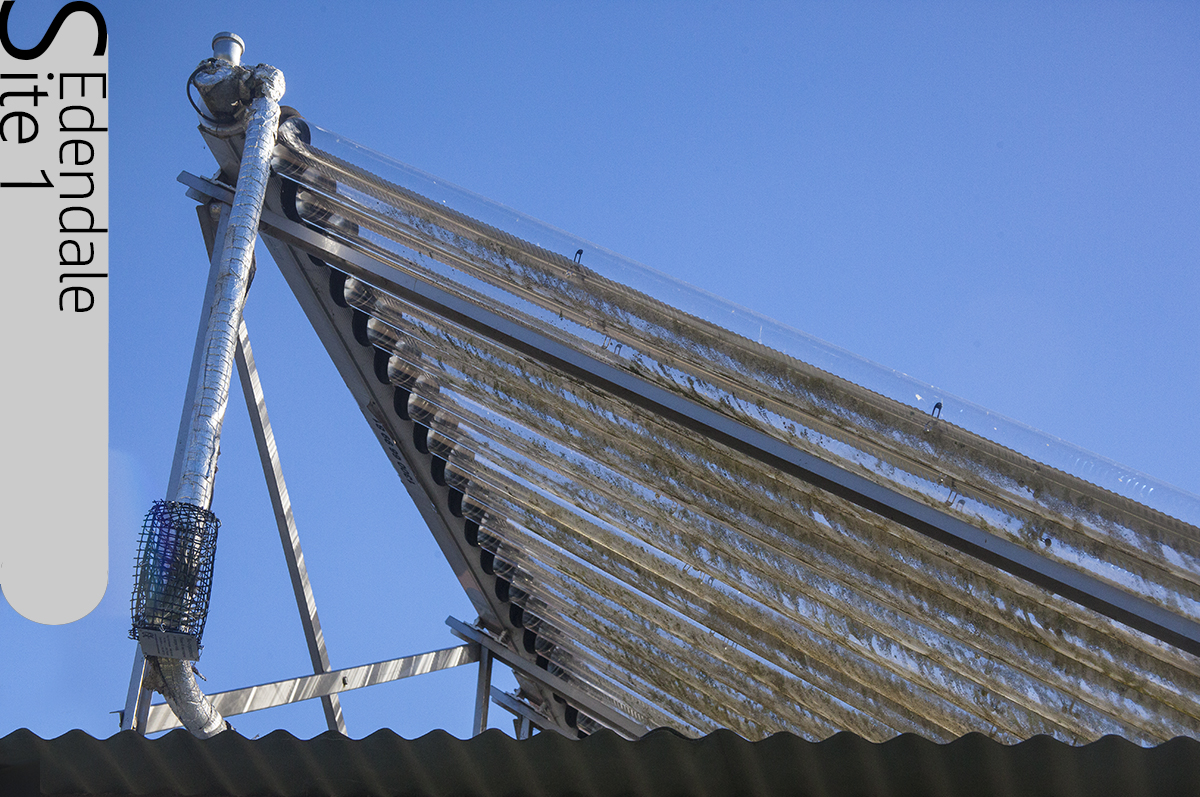
|
Tillandsia SWARM sites
The aim of this ecological art / science initiative is to:
- position the plant cells on a wide range of urban infrastructure often perceived as at incongruence to plants that provides a future pattern - like on the pipes of a solar water heater
- to surprise the audience with plants that need no support at the extreme locations
- to locate the plants in biologically extreme situations and test their survival and adaption - like level 92 of Eureka Tower
|
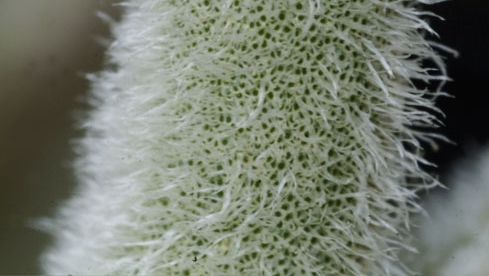
|
Biomonitors
As mentioned, through their special trichome leaf cells, Tillandsias are able to absorb toxic airborne heavy metal particulates form the atmosphere and consequently offer a cost efficient and effective Biomonitor within the urban environment. After a period of time a leaf sample can be tested in a laboratory as an indicator of comparative pollution levels at the various Tillandsia SWARM sites in the urban environment. The worlds leading Bromeliad biologist, David Benzing is who invented the process is assisting with this work. Starting with lichens in the Jardin du Luxembourg, Paris in 1886, biomonitoring has helped to track air pollution. |

|
AIR
AIR, is a gallery-based work. Tillandsias and their cages are combined to form the word AIR. However, here, each plant and cage corresponds to a plant and cage outside the gallery walls, and viewers are provided with a photograph, location, installation date and QR code / short URL that directs to further information on the particular site.
- Air is an interactive living sculpture using Tillandsias commonly known as air plants
- It consists of more than 30 mesh cages containing air plants arranged to form the letters AIR
- The work suspends within the gallery and is free to rotate. Each plant cage corresponds to a similar plant cage of the Tillandsia SWARM project which are located at various urban sites and includes Eureka Tower, CH2 building, Federation Square, Essendon Airport, Montsalvat, The Friend’s School Hobart, Monash Gallery of Art and Australian Print workshop
- At the end of each cage is a photograph, details of the location, install date and a QR code / short URL that directs the audience to further information on that site
Separated by geography and context, AIR is an expanding, ecological sculpture in two parts.
One aspect sees a diaspora of Tillandsias (air plants) located in protective mesh cages various urban sites.
In the second, corresponding plant cages are combined to manifest as the word AIR, but within a gallery context. Didactic panels offer details and a photograph of the analogous location, install date and a QR code / short URL that directs the audience to further information on that site.
While deliberately ambiguous, the title AIR, points to the role plants play in purifying the air we breathe. Through sophisticated biological adaption, air plants are able to absorb all water/nutrients, and even heavy metal airborne particulates through special leaf cells and can be used as biomonitors. Curiously they are one of few plant families that use a CAM cycle to capture CO2 and release oxygen at night.
Separated by geography and context, AIR is an expanding, ecological sculpture in two parts.
One aspect sees a diaspora of Tillandsias (air plants) located in protective mesh cages various urban sites.
In the second, corresponding plant cages are combined to manifest as the word AIR, but within a gallery context. Didactic panels offer details and a photograph of the analogous location, install date and a QR code / short URL that directs the audience to further information on that site.
While deliberately ambiguous, the title AIR, points to the role plants play in purifying the air we breathe. Through sophisticated biological adaption, air plants are able to absorb all water/nutrients, and even heavy metal airborne particulates through special leaf cells and can be used as biomonitors. Curiously they are one of few plant families that use a CAM cycle to capture CO2 and release oxygen at night. |
 |
Strength of a colony
Inside the plant cell are plants of different species, each with a single plant shoot. As a small single plant, they are highly vulnerable, and much less resilient than a larger colony. This was a deliberate strategy to test the plants under extreme conditions. Also, part of the aim of the experiment was to locate the air plants in challenging sites in a wide range of micro climates like rain shadows. As evidenced from site one Eureka Tower the plants take over a year to acclimatize, but once they multiply and form a colony the resilience increases dramatically. The plants at this site expanded from 1 to 12 in there years.
|
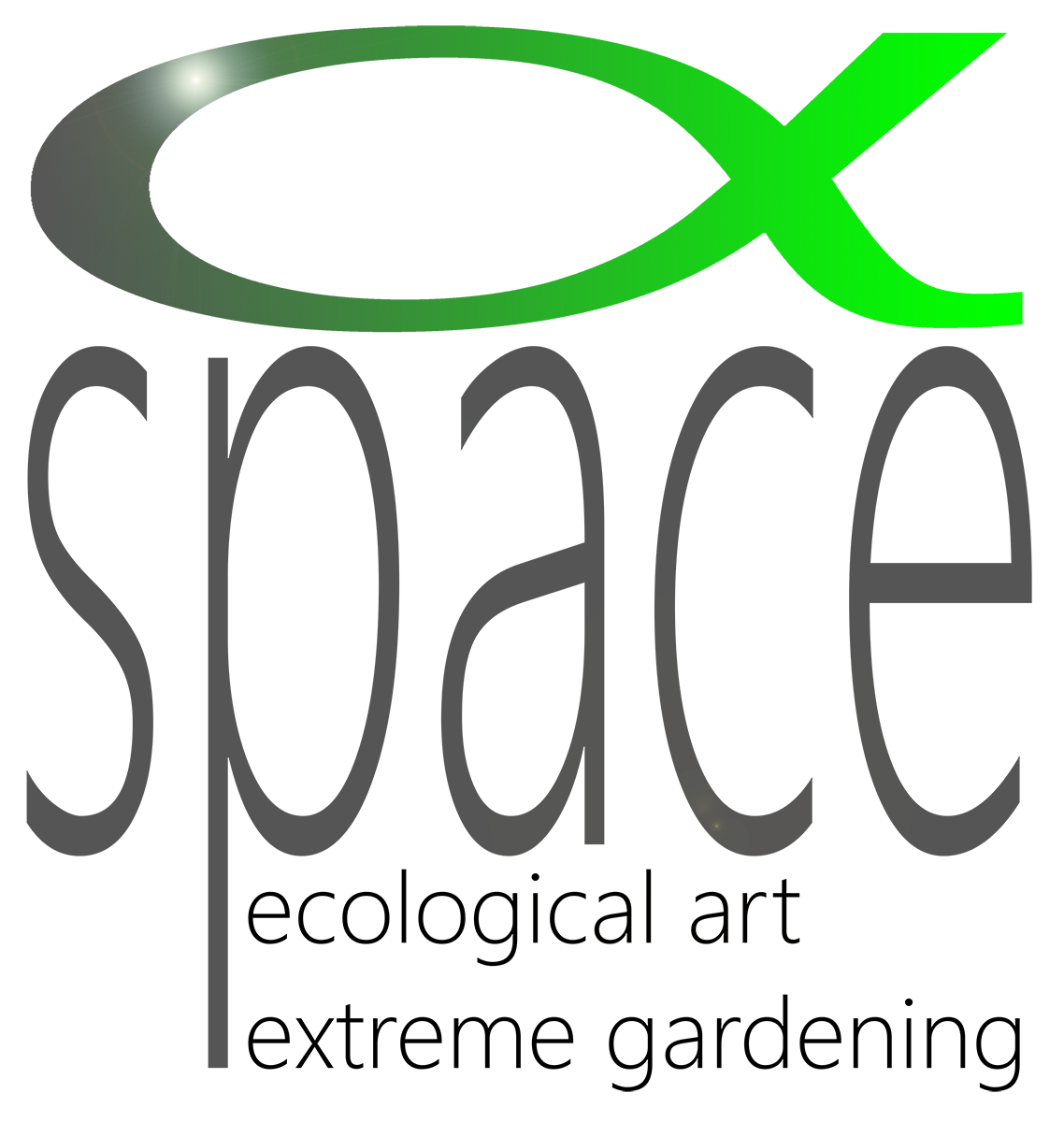
|
Alpha Space
- With the suspended air plant sculptures like those installed for the Airborne project, we are interested in exploring how plants can occupy space but not surface. Suspension on and via wires extends the potential habitat of plants into what I term Alpha Space. While vertical and roof top gardens have become popular in major cities worldwide, they occupy surface, but these intriguing ground breaking air gardens step beyond earthly confines to rotate suspended in air or Alpha space.
- For many decades, my work had been termed environmental art. But more recently this term has been claimed by artists who create virtual environments. Ecology is the branch of biology dealing with the relations and interactions between organisms and their environment, including other organisms. I experiment using air plants within both ecology and an art context.
- The 22 March, 2015, on-line edition of The AGE newspaper, termed the experiments on Eureka tower as “Extreme Gardening”. It was such a great concept for what we are doing with the Tillandsias within the urban environment, we decided to adopt it.
|
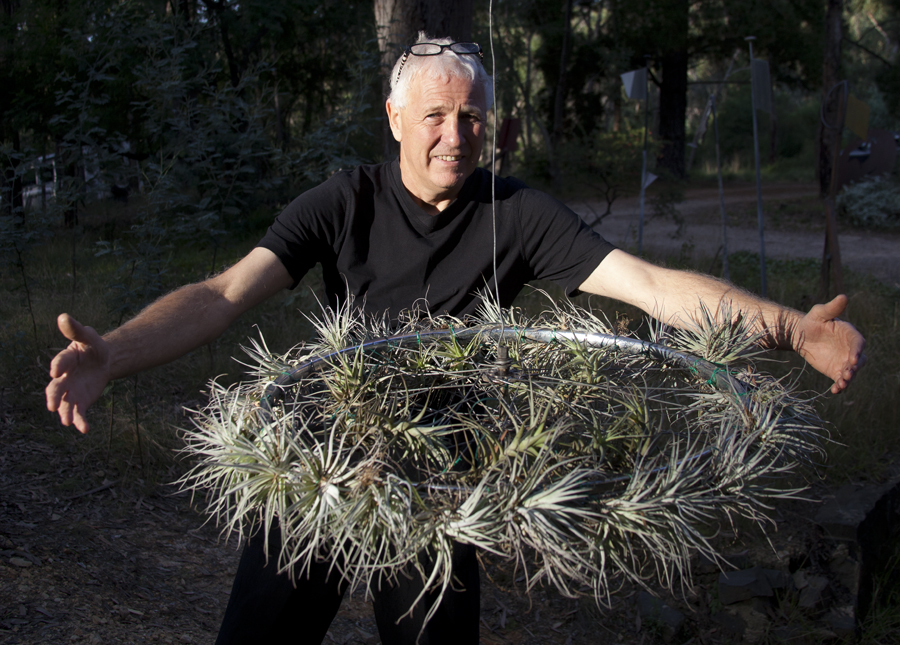
|
Team
Lloyd Godman: MFA : Ecological artist
- As a key aspect of his MFA study from 1996 at RMIT, Lloyd worked with Bromeliad plants and particularly air plants. After 20 years experimenting with air plants and realizing many plant based art projects in New Zealand, Australia, U.S.A. and France he is now acknowledged as a leader in this field.
- “Lloyd Godman is one of a new breed of environmental artists whose work is directly influencing ‘green’ building design......Godman’s installations are the result of a unique blend of botanical science, environmental awareness and artistic expression. All three elements are intrinsic to the practical realization of his polymathic vision”. - John Power - Editor of Facility Management
Magazine Aug 2011
|
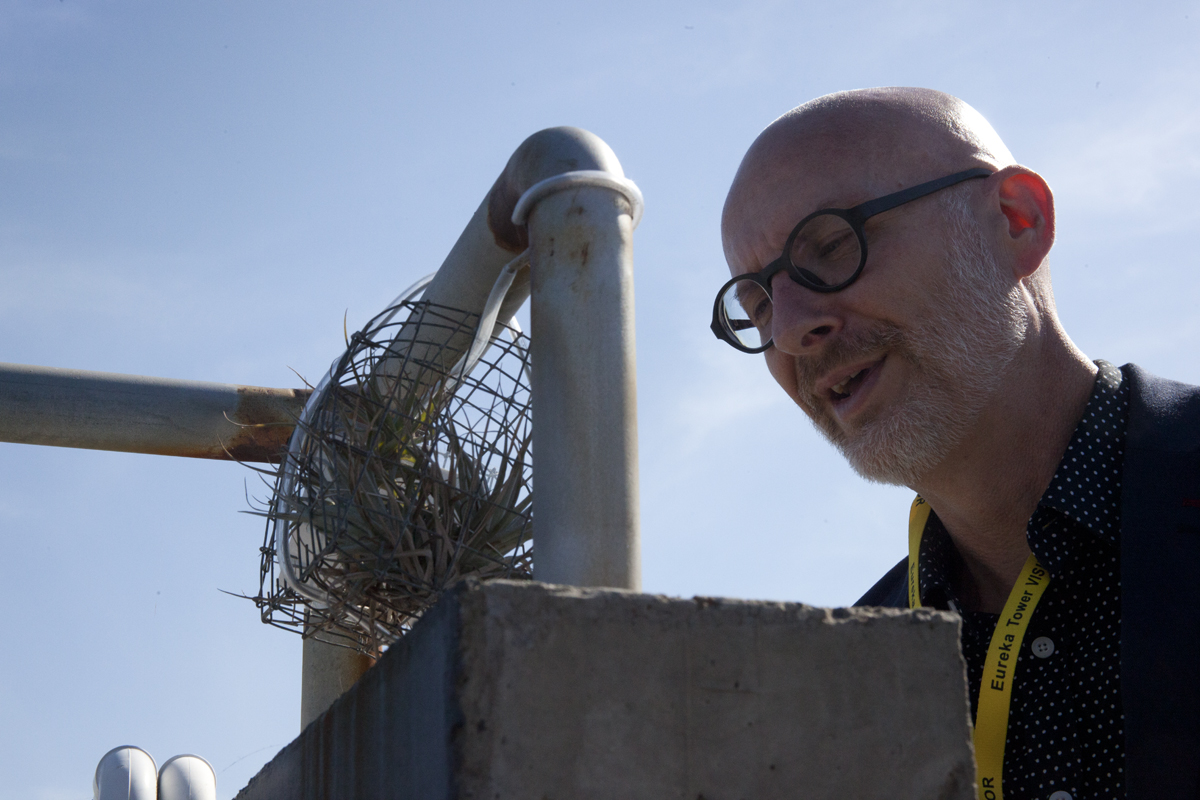
|
Stuart Jones: Structural Engineer BE(Civil & Computing), FIEAust, CPEng, NPER
- Stuart Jones is Technical Director for Arcadis in Melbourne. Previous to this he was the Owner/ Director of Point 5 Consulting in Melbourne for 14 years. Stuart has over 25 years professional experience in all phases of project delivery and specializes in creative structural design with extensive experience in Australia and throughout Asia.
- Stu was the senior structural engineer who oversaw the building of Federation Square in Melbourne
|
 |
Grant Harris: Environmental Scientist & Arboricultural Consultant
- Grant Harris is the principle of Ironbark Environmental Arboriculture, with over 12 years experience in the arboricultural sector he also holds a degree in Environmental Science (Wildlife and Conservation Biology). His particular areas of interest are the use of green infrastructure to mitigate urban heat island effects and urban ecology.
|
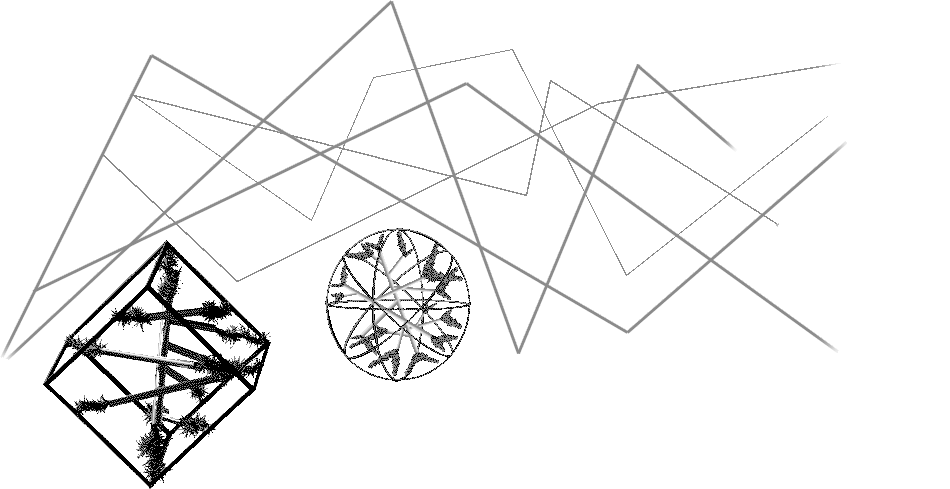
|
|
|
|